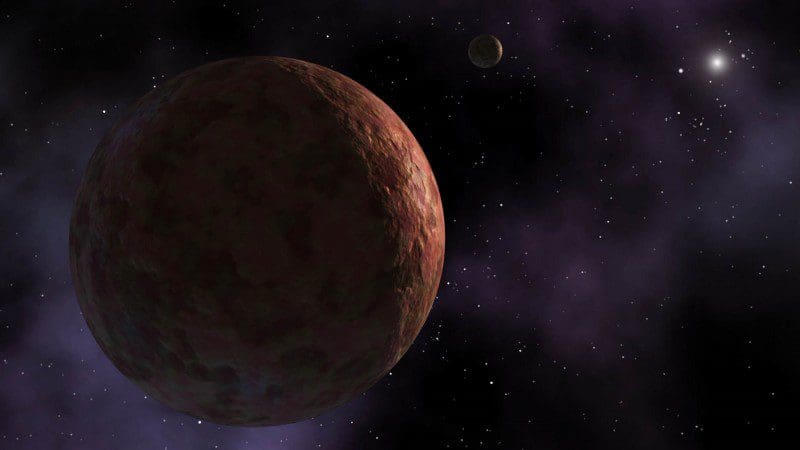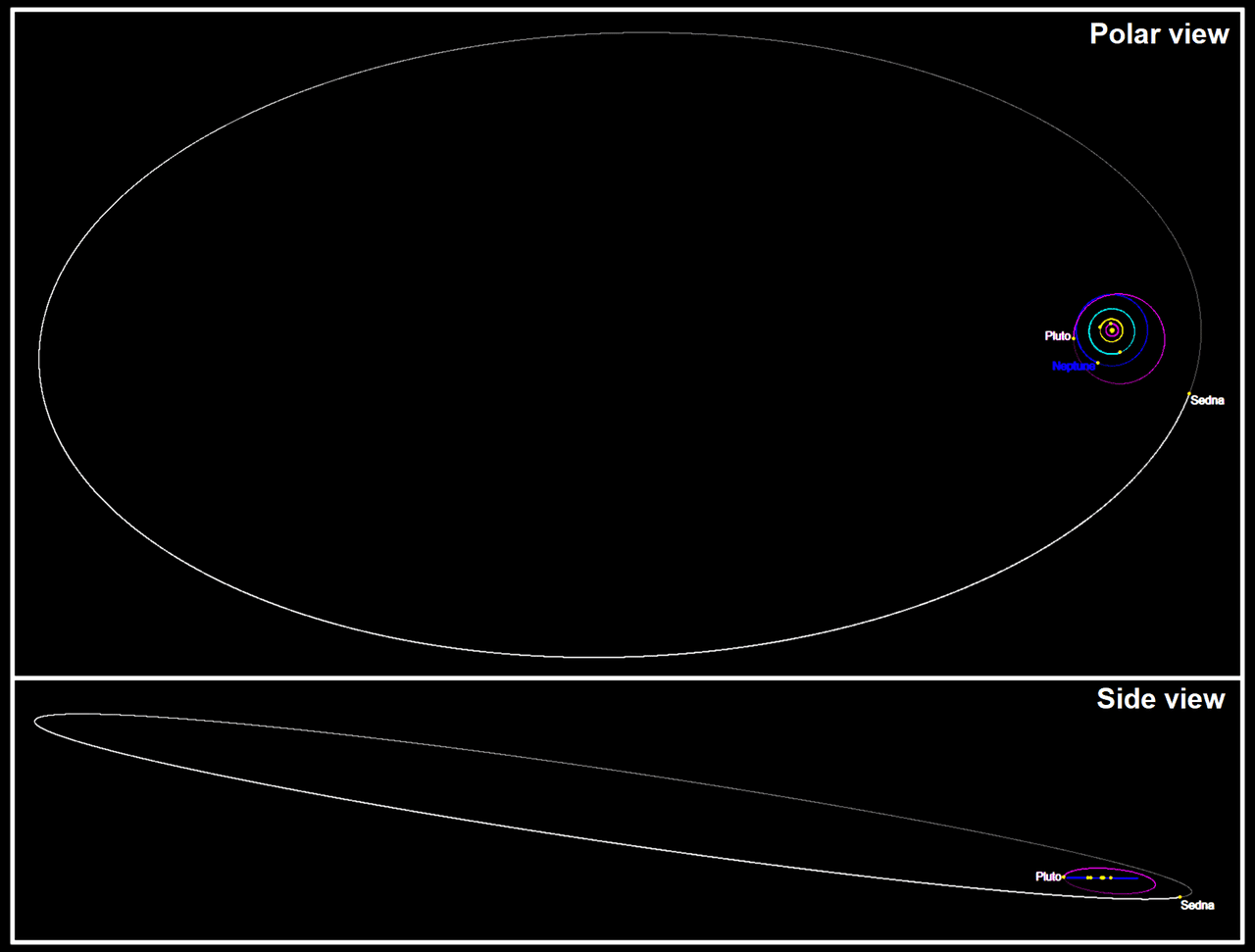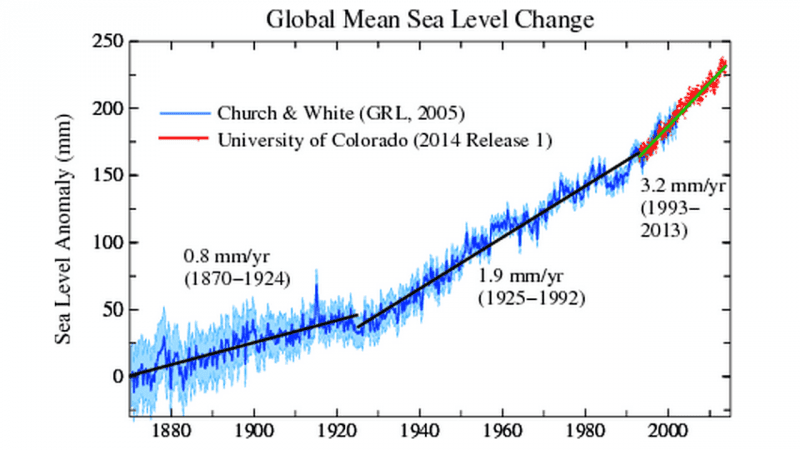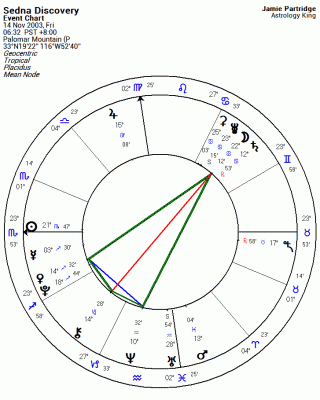Planet Sedna has the longest orbital period of any planet by far, taking 11,400 years to orbit the Sun. It also has a very elongated orbit, possibly the result of influence by a binary companion to the Sun (Nemesis), responsible for cyclic nature of mass extinctions on Earth from comets.
Sedna nears its perihelion in mid 2076. The last time Sedna was this close to earth was in 9400 BC, the beginning of the Neolithic Age when we started harvesting wild cereals and keeping animals like dogs and goats. We were evolving away from our nomadic roots.
In paleoclimatology, 9400 BC was the start of the Preboreal Period, coinciding with a “sharp rise in temperature over 50 years”.[2] This led to inundation of low-lying areas of our planet. Sound familiar? This makes me believe that Sedna is linked to climate change, global warming and the rapid sea-level rise we are witnessing over just one generation. Since I was born the sea level has risen over 10 cm, or over 4 inches. And as the graph below shows, the current rate of sea level rise is over 3 cm every 10 years, and increasing.Is this caused by human activity such as the burning of fossil fuels? Or is it simply the effect of the planet Sedna coming close to earth? The similarities to 9400 BC are plain to see. Perhaps human activity is making the current increase in temperature more dramatic, we will have to see. Sedna reaches it perihelion in about 60 years. I would expect the changes in our climate to escalate as Sedna nears earth. More frequent and more extreme weather events.
Planet Sedna Astrology
The orbital period of Sedna has me convinced it is now causing climate change. But does the Sedna astrology chart indicate anything like this? Planet Sedna was discovered on 14 November 2003 in California. The time for the discovery chart is rated AA and comes from Astro Databank, Astrology: Celestial: Sedna Discovery.
The conjunction of the Moon, asteroid Hygeia and minor planet Ceres does indicate public health concerns regarding the environment. In mundane astrology, the Moon rules the public, in this case the global population. Asteroid Hygeia rules public health, medicine, disease and diet.
Minor planet Ceres has been shown by astrologers including myself, to relate to the environment, climate change and global food production. Interestingly, I wrote that post about Ceres in relation to a climate change conference. Ceres and the new moon were at 24 degrees Scorpio, the Ascendant in the Sedna discovery chart. The same degree that Saturn stations retrograde on 3 March 2014, when it is opposite Sedna.
Venus sextile Neptune creates sensitivity and compassion, in this case perhaps, idealism and concern for the oceans, or sensitivity to the changing vibrations caused by the approach of Sedna? Just tossing ideas up. Anyway, this compassionate idealism channels down to Saturn at the apex of a Yod aspect pattern. A Yod apex planet condenses the energy of the sextile planets, in the same way Saturn is known for materializing and condensing matter. It grounds this energy, bringing it down to earth, making it serious, limiting and negative.
Thus, our sensitivity to Sedna turns to worry and fear about how climate change is limiting our options, impacting on food production, reducing the area of habitable and arable land. Saturn rules agriculture, the land, and real estate, all of which are in danger from sea level rise and extreme weather conditions.
Saturn is conjunct the brightest star in the heavens, the fixed star Sirius. The custodian, the guardian. Is this our responsibility? Have we been good custodians of the planet Earth. What legacy do we leave our children? Saturn rules inheritance, and it also rules karma. However the energy in this Yod does not end with Saturn. This is a Boomerang Yod. Saturn fears bounce back to Chiron, the wounded healer, the medicine man. The inventor of astrology, who foretold events from the stars.
Chiron was immortal, but he gave up this right because of the suffering from his eternal pain. As reward for his gifts to man, and for his sacrifice, the gods placed him in the sky as the constellation Centaurus. The 10th brightest star in the sky is beta Centaurus, the fixed star Agena. This star is rising with the Sun in the Sedna discovery chart. So what does Chiron see in the stars for our future? He sees that we have to teach our kids to swim.[wp_ad_camp_3]
References
- By Tomruen – Own work, CC BY-SA 4.0, https://commons.wikimedia.org/w/index.php?curid=60453344
- List of periods and events in climate history – Wikipedia.




I can see Sedna as a harbinger of earth changes… she definitely seems to speak to us of our interrelationship with the Earth and Sea.
We could certainly utilize Mars in Cancer to align ourselves better with Universal Flow, and Universal Will.
Oh, I don’t doubt for a second that we’re coming out of an age of crap.
The Earth, it’s vomiting…
Would Mars in Cancer have anything to do with this?
So we are leaving the “Age of Crap”, yay! Mars was heavily aspeted in that chart, tied into all those aspects I mentioned.
From twitter.com/RobertCurrey
Earthquakes > 5mag: Thu:14 quakes [avg 5.29] in 4 regions. Wed:24 quakes [avg 5.3] in 6 regions. Tue:17 quakes [avg 5.78] in 3 regions.
“Not surprising that water is a big theme in the world today, from lack of in certain places, to increasing numbers and intensity of hurricanes. The sea level is rising at about 3 mm per year. Now tsunamis are in the news with Sedna in tight aspect, getting closer to Earth than it has been for over ten thousand years. We know the mythology of the name relates to the ocean, Sedna the Inuit goddess of the sea.”
When I saw the wiped out angling stock news which happened on the same fateful Japan quake, with Sendai(that rhymes with Sedna) worst hit; I’m beginning to wonder…if it is time to know and recognize Sedna a bit more.
bbc.co.uk/news/uk-wales-12717872
Here’s the BBC link which baffled a lot of people and assumed poisoning is the main cause until proven otherwise. But who can tell for sure?
Thanks KK, definitely worth keeping an eye on Sedna. Not much astrological research been done yet so it might be worth looking at the discovery chart. Astro Databank has some information on that. The computer discovered it on 14 November 2003 at 06:32:57 am, Palomar Mountain CA, USA. But the first human to view the photographic plates, Michael Brown, didn’t see them till 19 November 2003, 10:50 am (at the same observatory I assume). astro.com/astro-databank/Celestial:_Sedna_Discovery
Jamie and KK – thinking about how we ‘frame’ (literally, she was framed) Sedna – It might be worth remembering that in the Sedna story she is expelled from the community for an un-named violation of social mores – her father takes her ourt to sea and dumps her – why worth noting? Patriarchy ruling the roost is why she ended up an outcast – this is too big a feature of her story to be left out + she is the person to whom the hunters go when they are about to set out on the hunt – they have to ask her favour in order for the hunt to be successful as she is the mistress of the animals…..
just to clarify – I view Sedna as indicating the re-balancing of male/female issues around social moresand how they affect the balance of humans with nature + she operates from within the Neptunian realms, has archetypal ower at her disposal on a very human level – she also has a ceation myth element as her fingers became the seals, whales and dolphins in the Inuit version….with her coming in v close to earth she’s bringing these issues home now….millions of dead fish etc?
“with her coming in v close to earth she’s bringing these issues home now….millions of dead fish etc?”
Have you read the latest findings on the Gulf spill, released late Feb or early this month? That BP is talking bollocks about recovery in two years, when their findings indicate that it would probably take another two decades to reinstate the biological life underwater.
Good to have the mythology input Rob. I think I might change this article at some stage and revamp it with more info and research. Another one on the in-tray!
Interesting point. Especially if we view the sea as female, and building are man made. Sedna´s back to exert her power on man´s feeble attempts to harness nature ( nuclear energy?).
I think we´ve yet to see what else Sedna´s up to.
I have started putting Sedna in my charts especially for mundane events. Noticed it was on the MC for the first explosion at the Japanese power plant.
“Patriarchy ruling the roost is why she ended up an outcast”
Will process this on my subconscious. Looks like this is no ordinary water theme. Thanks Rob!
Jamie – in the article you mention that Sedna was closest to earth last at the end of the last Ice Age and may be connected with earth changes – I agree, and look forward to your updates here – actually I am thinking all the earth related goddesses and astro female astro figures need to be looked at in unison right now as they are all indicating the hot issues that are coming up within our earth/nature/human dance
Oh yes, been thinking about it as well Rob. The astro female goddesses are here to stay! I wish Jamie would explore my favorite Vesta real soon. Talk about the recent International Women’s Day…should have thrown the goddesses in there too.
Interesting we’re discussing this with Lilith conjunct Uranus. Marina will be happy I’m adding another girl to the sky map! Sedna will start to line up with the fixed star Algol from 2018.
Glad Marina is all too comfortable with these ‘ladies’ around. Another one to join your goddess ‘harem’, Jamie! lol
I’ve been sharply brought by Spirit to look at Sedna – it is conjunct my natal merc and sun conj in Aries 25 and 26 degree right on the cusp of 6th to 7th house
crucifixion issues for the collective – i’m certain it’s a collective re balancing and calibrating etc as we co create living Heaven here now and hit shamballah while releasing our attachments to the illusory in earnest following our own spirits without hesitation
i am an oracle – have been all my life – channeled ancient wisdom – no nonsense – many warriors – and now it’s just balance the male/female – forgive yourself and bless the waters of this planet
i contend we reached critical mass recently as a ‘psychic medium’ and ‘kinesthetic’ type who’s body does not lie to me – we lucked out – we did it and that means there’s enough of us doing shamanic alchemy to transmute that which is doing the opposite and not helping the purifying process Gaea IS going thru regardless
things won’t be so bad and yet we will all ride the tsunami i dreamed of in Oct 2011 – so being prepared is just smart – as is remaining clear and helpful and balanced in body and mind spirit – following your own bliss and Spirit – in JOY
Gratitude for the WATERS helps – we ARE the waters aka water is consciousness
peace out
for those interested here’s my ‘chart’ – lol – it’s aspects might cause of few eyebrows to raise up – not to worry i don’t seek human fame – and fortune is annoying belief system some moron devised future tripping and actually believing his own lies to avoid his own real problems personally – abusing the world for being a huge disappointment – the globe has kids like this – that is a bitch – so i’m calling out the freaks who want to be awake – and asking
how much happiness can you take? no one answered yet lol
oh birthdate for obsessive compulsives
4/15/58 6:39pm newark new jrrrrrrrsy
HI Jamie I have natal sedna conjunct my natal sun and karma in the 11th(all in the same orb 1 degree) . Could you please explain what it means?
Not sure about asteroid karma but Sedna suggests an affinity with global warming to me.
During January, 2019, transiting Saturn activates the Sedna discovery Yod. Saturn at the poles.
Reminds me of the last Yod activation that recently played out. The Election of Pope Francis, with Jupiter at the fulcrum, transiting Jupiter at the Apex, when all that pope stuff came down.
Is it possible that Sedna’s last nearest approach to the inner Solar System, created Birkeland currents and the consequential effects articulated by several independent scientists and astrologers?
https://www.sott.net/article/420386-Did-Earth-Steal-Martian-Water
Today I am considering Sedna is so named, partly, because of the geographic Laurentian connection. The Sedna myth is woven through the science of the Younger-Dryas extinction event?
I’ve taken an interest in Sedna because it’s conjunct my Chiron. 18 years ago, I nearly had a finger amputated in a workplace accident. I keep an eye out for transits to Sedna. Last year when it was conjunct Algol, 3 people suffered finger injures at my workplace within a few days of each other.